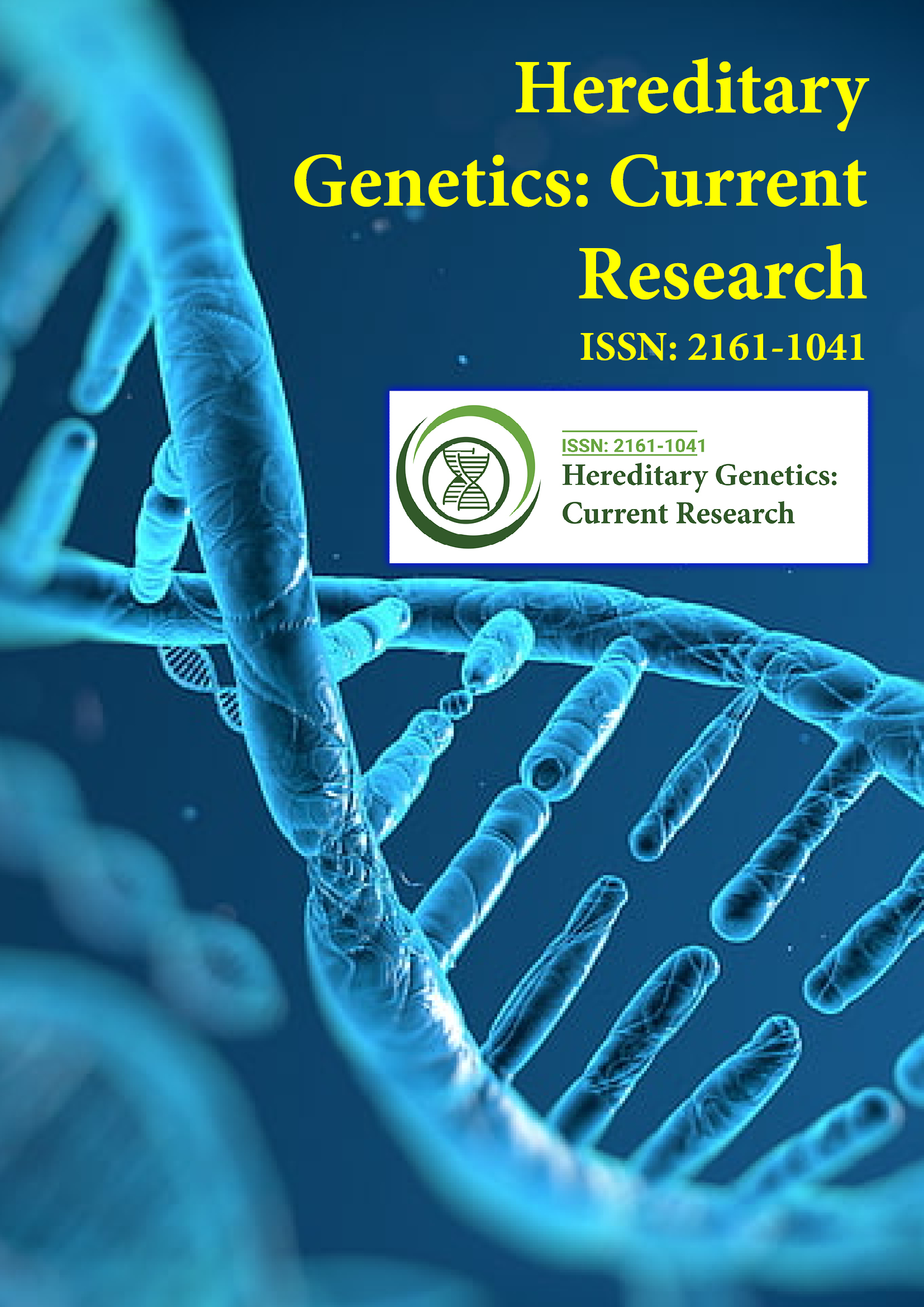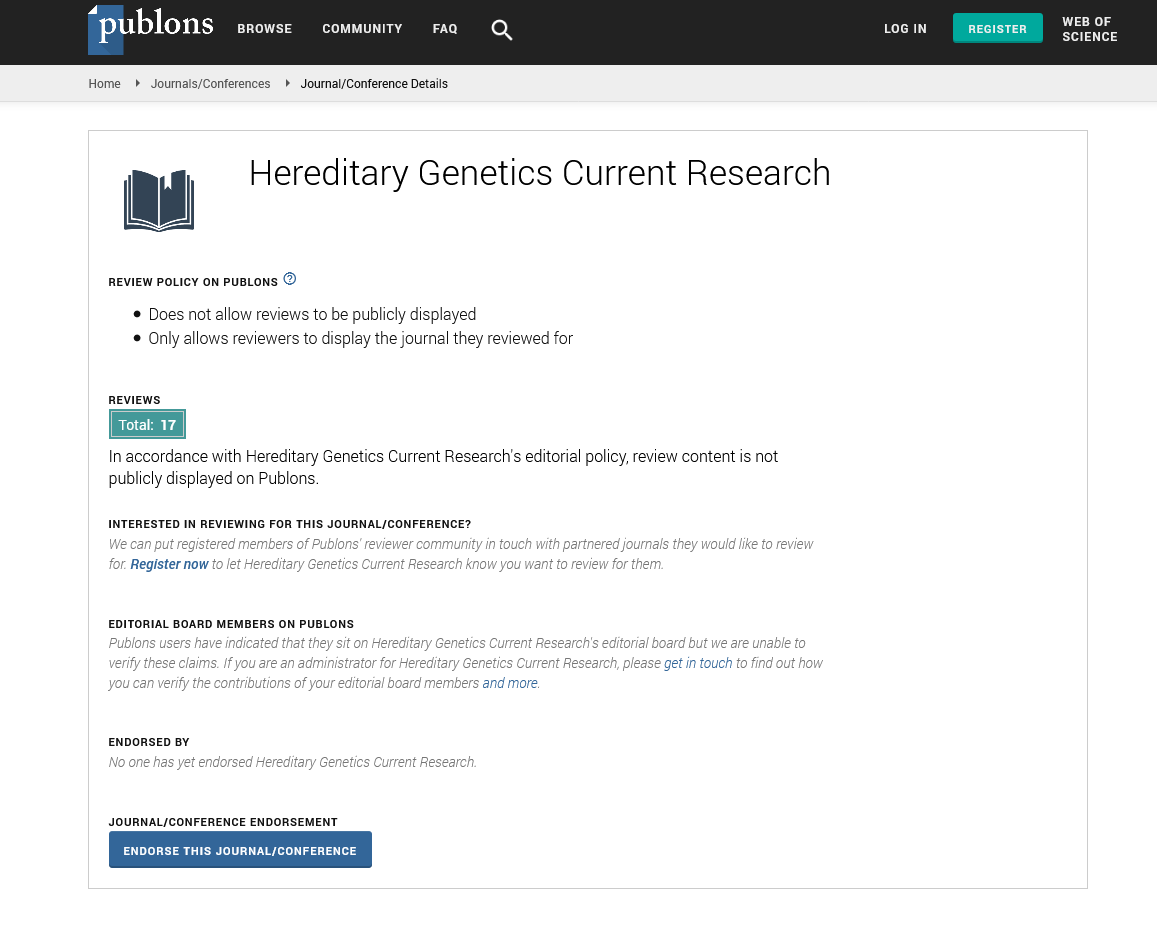Indexed In
- Open J Gate
- Genamics JournalSeek
- CiteFactor
- RefSeek
- Hamdard University
- EBSCO A-Z
- NSD - Norwegian Centre for Research Data
- OCLC- WorldCat
- Publons
- Geneva Foundation for Medical Education and Research
- Euro Pub
- Google Scholar
Useful Links
Share This Page
Journal Flyer

Open Access Journals
- Agri and Aquaculture
- Biochemistry
- Bioinformatics & Systems Biology
- Business & Management
- Chemistry
- Clinical Sciences
- Engineering
- Food & Nutrition
- General Science
- Genetics & Molecular Biology
- Immunology & Microbiology
- Medical Sciences
- Neuroscience & Psychology
- Nursing & Health Care
- Pharmaceutical Sciences
Short Communication - (2024) Volume 13, Issue 4
Advances in Imaging and Genetics of Hereditary Ovarian Tumors: A Comprehensive Review
Rachel Smith*Received: 29-Nov-2024, Manuscript No. HGCR-24-28200; Editor assigned: 02-Dec-2024, Pre QC No. HGCR-24-28200 (PQ); Reviewed: 16-Dec-2024, QC No. HGCR-24-28200; Revised: 23-Dec-2024, Manuscript No. HGCR-24-28200 (R); Published: 30-Dec-2024, DOI: 10.35248/2161-1041.24.13.292
Description
Hereditary ovarian tumour syndromes represent a unique and challenging subset of ovarian cancers, accounting for approximately 10%-25% of all cases. These syndromes are primarily associated with germline mutations in cancer predisposition genes, including BRCA1, BRCA2 and genes involved in DNA mismatch repair pathways, such as MLH1, MSH2, MSH6 and PMS2, which are implicated in Lynch syndrome. The combination of advanced genetic technologies and imaging techniques has significantly enhanced our understanding, diagnosis and management of hereditary ovarian tumours.
Recent advances in genetics have identified several new susceptibility genes beyond the canonical BRCA mutations. Genes such as RAD51C, RAD51D and BRIP1 have been linked to an elevated risk of ovarian cancer, expanding the scope of genetic testing. Multi-gene panel testing, provided by institutions such as Harvard Medical School and the Max Planck Institute, has become a foundation for identifying hereditary cancer risks. The identification of these mutations enables personalized risk assessment, targeted surveillance and prophylactic interventions, such as risk-reducing salpingo-oophorectomy [1-3].
From an imaging perspective, hereditary ovarian tumour syndromes present distinct challenges and opportunities. Imaging modalities play a critical role in screening, early detection and monitoring of ovarian tumours, particularly in high-risk populations. Ultrasonography, Magnetic Resonance Imaging (MRI) and Computed Tomography (CT) are routinely employed, each offering unique advantages [4,5]. Ultrasound remains the first-line imaging modality due to its accessibility and sensitivity in detecting ovarian masses, while MRI is increasingly recognized for its superior soft tissue contrast and ability to distinguish benign from malignant lesions [6].
Advanced imaging techniques, such as Diffusion-Weighted Imaging (DWI) and dynamic contrast-enhanced MRI, are particularly valuable in characterizing ovarian tumours in hereditary syndromes. These methods provide functional and vascular insights, enhancing diagnostic accuracy. Research conducted at the Mayo Clinic and Karolinska Institute has highlighted the potential of quantitative imaging biomarkers, such as Apparent Diffusion Coefficient (ADC) values, to stratify tumour aggressiveness and predict therapeutic response [7,8].
In Lynch syndrome, which predisposes individuals to ovarian and endometrial cancers, imaging plays a significant role in early detection and staging. Studies from Kyoto University and the University of Toronto have demonstrated the utility of advanced MRI techniques in identifying early-stage tumours in this population, facilitating timely surgical and therapeutic interventions.
The exchange between genetics and imaging is also reforming the environment of hereditary ovarian tumour syndromes. Functional imaging techniques, such as Positron Emission Tomography (PET), are being combined with genetic risk profiling to enhance tumour characterization and monitor response to targeted therapies. For example, BRCA-mutated tumours often exhibit heightened sensitivity to DNA-damaging agents such as platinum-based chemotherapies and Poly (ADPRibose) Polymerase (PARP) inhibitors. Imaging biomarkers are increasingly used to evaluate the effectiveness of these treatments, providing a non-invasive means of tracking therapeutic efficacy [9].
Epigenetic mechanisms are another area of active investigation in hereditary ovarian tumours. Epigenetic changes, such as promoter hypermethylation of BRCA1, have been observed in patients without germline mutations, mimicking hereditary cancer syndromes. These findings highlight the complexity of hereditary ovarian cancer genetics and the need for innovative diagnostic approaches. Institutions such as the Broad Institute and the Swiss Federal Institute of Technology are pioneering research into the epigenetic environment of ovarian tumours, which may eventually lead to novel diagnostic and therapeutic strategies [10].
Despite these advancements, significant challenges remain. Screening for ovarian cancer in high-risk populations continues to be a controversial topic. While transvaginal ultrasound and serum CA-125 testing are commonly used, their effectiveness in reducing mortality remains limited. Ongoing research aims to develop more sensitive and specific biomarkers for early detection, integrating genetic and proteomic data with advanced imaging techniques.
Furthermore, the management of hereditary ovarian tumour syndromes requires a comprehensive approach, combining the expertise of geneticists, oncologists, radiologists and surgeons. Prophylactic surgeries, such as risk-reducing salpingooophorectomy, have proven highly effective in reducing cancer risk but come with significant implications for quality of life and fertility. Shared decision-making, guided by comprehensive genetic counseling and risk assessment, is essential in navigating these complex choices.
In conclusion, the combination of genetic and imaging advances is transforming the diagnosis and management of hereditary ovarian tumour syndromes. By identifying new genetic risk factors and refining imaging techniques, researchers and clinicians are creating the way for personalized care and improved outcomes. Collaborative efforts across leading institutions worldwide are essential to tap into the full potential of these innovations, addressing the unique challenges posed by hereditary ovarian cancers. As the field continues to describe, the synergy between genetics and imaging will undoubtedly play a significant role in forming the future of ovarian cancer care.
References
- Yoshida R. Hereditary breast and ovarian cancer (HBOC): Review of its molecular characteristics, screening, treatment and prognosis. Breast Cancer. 2021;28:1167-1180.
[Google Scholar] [Crossref] [PubMed]
- Paluch-Shimon S, Cardoso F, Sessa C, Balmana J, Cardoso MJ, Gilbert F, et al. Prevention and screening in BRCA mutation carriers and other breast/ovarian hereditary cancer syndromes: ESMO Clinical Practice Guidelines for cancer prevention and screening. Ann Oncol. 2016;27 (Suppl 5):103-110.
- Antoniou A, Pharoah PD, Narod S, Risch HA, Eyfjord JE, Hopper JL. et al. Average risks of breast and ovarian cancer associated with BRCA1 or BRCA2 mutations detected in case Series unselected for family history: A combined analysis of 22 studies. Am J Hum Genet. 2003;72:1117-1130.
- Moyer VA. Risk assessment, genetic counseling and genetic testing for BRCA-related cancer in women: U.S. Preventive Services Task Force recommendation statement. Ann Intern Med. 2014;160:271-281.
[Google Scholar] [Crossref] [PubMed]
- Kemp Z, Turnbull A, Yost S, Seal S, Mahamdallie S, Poyastro-Pearson E, et al. Evaluation of cancer-based criteria for use in mainstream BRCA1 and BRCA2 genetic testing in patients with breast cancer. JAMA Net Open. 2019;2:e194428.
- Ficarazzi F, Vecchi M, Ferrari M, Pierotti MA. Towards population-based genetic screenings for breast and ovarian cancer: A comprehensive review from economic evaluations to patient perspectives. Breast. 2021;58:121-129.
[Google Scholar] [Crossref] [PubMed]
- Manchanda R, Lieberman S, Gaba F, Lahad A, Levy-Lahad E. Population screening for inherited predisposition to breast and ovarian cancer. Annu Rev Genom Hum Genet. 2020;21:373-412.
[Google Scholar] [Crossref] [PubMed]
- Ludt S, Heiss F, Glassen K, Noest S, Klingenberg A, Ose D, et al. Patients’ perspectives beyond sectoral borders between inpatient and outpatient care: Patients’ experiences and preferences along cross-sectoral episodes of care. Gesundheitswesen. 2014;76:359-365.
[Google Scholar] [Crossref] [PubMed]
- Saguatti G, Naldoni C, Benelli E, Fedato, C, Frigerio A, Galli V, et al. Letter to the Editor regarding the paper by F. Cardoso et al. ‘European Breast Cancer Conference manifesto on breast centres/units’. Eur J Cancer. 2017;87:199-200.
- Balmaña J, Sanz J, Bonfill X, Casado A, Rué M, Gich I, et al. Genetic counseling program in familial breast cancer: Analysis of its effectiveness, cost and cost-effectiveness ratio. Int J Cancer. 2004;112:647-652.
[Google Scholar] [Crossref] [PubMed]
Citation: Smith R (2024). Advances in Imaging and Genetics of Hereditary Ovarian Tumors: A Comprehensive Review. Hereditary Genet. 13:292.
Copyright: © 2024 Smith R. This is an open access article distributed under the terms of the Creative Commons Attribution License, which permits unrestricted use, distribution, and reproduction in any medium, provided the original author and source are credited.

